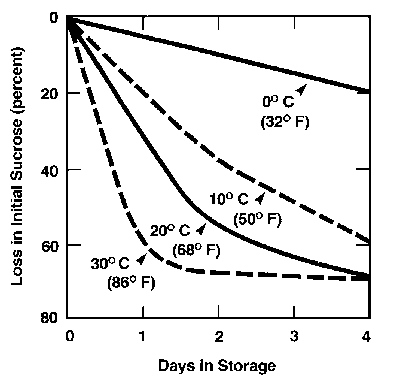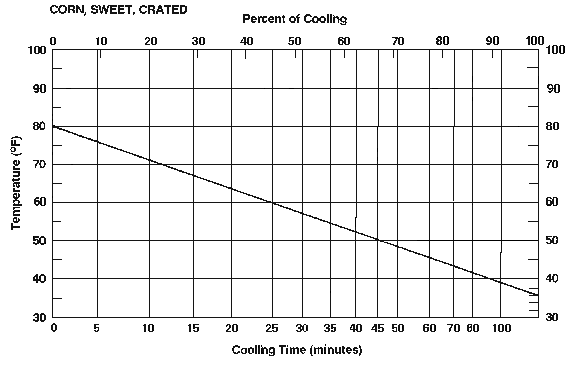Freshness Facts
| Preferred cooling method: | Hydrocooling, icing |
| Optimum temperature: | 32°F |
| Freezing temperature: | 31°F |
| Optimum humidity: | 90 to 98% |
| Storage life: | 5 to 7 days for standard varieties; 8 to 12 days for supersweet varieties |
Sweet corn is a highly perishable crop. When produced for commercial markets, it must be cooled immediately and thoroughly after harvest to protect its quality. It must be kept cool until it reaches the consumer. Mishandling sweet corn causes serious and irreversible deterioration in quality and loss of sweetness and tenderness. Because temperatures are usually high in midsummer when sweet corn is harvested in North Carolina, growers, shippers, and processors must have access to cooling equipment and must have knowledge of proper cooling and handling methods. Only careful attention to postharvest handling procedures can ensure buyer satisfaction and marketing success.
This publication acquaints growers, shippers, and processors with energy-efficient cooling and handling methods useful in preserving the quality of fresh sweet corn.
Harvesting and Handling
Careful supervision of harvesting – whether done by hand or machine – results in fewer problems at the packing shed. Whenever possible, sweet corn should be harvested early in the morning when its moisture content is high. Also, the pulp temperature may be as much as 30°F lower at dawn than at midday. Harvesting in early morning is thus a good way to reduce cooling loads and save energy.
After harvest, the ears are normally transported to the packing shed in bulk trucks or trailers. Pulp temperatures at harvest are often higher than 90°F. At these temperatures, bulk lots of uncooled sweet corn will rapidly overheat because of the heat produced by respiration. (The respiration rate of sweet corn is among the highest of common fruits and vegetables; in fact, its rate is about eight times higher at field temperatures than at 32°F.)
If harvested ears are to be left in bulk trucks or trailers for more than an hour, they should be kept from direct sunlight and cooled with a steady flow of well water to remove as much of the field heat and heat of respiration as possible.
Water should be evenly distributed throughout the load with sprinklers to ensure complete coverage at the rate of approximately 1 gallon of water per 4 pounds of corn per hour. For example, a truck containing 10,000 pounds of freshly harvested sweet corn would require approximately:
10,000 ÷ 4 = 2,500 gallons of water per hour.
Well water temperatures during the summer in North Carolina average about 60°F, low enough to reduce markedly the total cooling load and thus the cost of subsequent refrigeration.
The care given sweet corn during harvesting should be matched by the attention it receives during packing. At the packing shed, sweet corn should be trimmed uniformly to eliminate flag leaves and long shanks. If left on the ear, they will cause packaging problems and induce further moisture loss. Objectionable kernel denting may occur with a moisture loss of 2 percent or less. Only first-quality sweet corn devoid of defects and of uniform maturity, color, shape, and size should be selected and packed. Any ears exhibiting signs of disease or mechanical or insect damage should be discarded along with any ears that lack adequate shuck coverage.
Most sweet corn is packed in wirebound crates holding 42 pounds net weight. Cabbage bags containing 41⁄2 to 5 dozen ears and wax-impregnated cartons containing 50 pounds net are also used. New growers should always consult with buyers to determine what type of shipping container they prefer. Buyers often perceive produce shipped in non-standard containers to be of lower quality than that shipped in standard containers.
Cooling and Storage
The taste and quality of sweet corn depends heavily upon its sugar content, which rapidly decreases after harvest if ears are allowed to remain at field temperatures. By lowering the temperature, the conversion of sugar to starch may be substantially slowed but not completely stopped. Loss of sugar is about four times as rapid at 50°F as at 32°F.
Newer supersweet cultivars contain over twice as much sugar as standard varieties and are more forgiving of delayed cooling and mishandling. For maximum quality and value, however, sweet corn must be continuously and properly refrigerated from harvest until it reaches the consumer.
Figure 1 demonstrates the effect of various storage temperatures on loss of sweetness. The ideal cooling process for sweet corn removes field heat rapidly and reduces the temperature to near 32°F. This is done in a two-stage process starting with hydrocooling of either packaged or loose corn. Hydrocooling by drenching or immersing in near-freezing water is effective in removing the critical highest heat (the upper two-thirds, or three-quarters of the difference between the harvest temperature and the water temperature). Because the rate of heat transfer is proportional to the temperature difference, hydrocooling removes heat much faster at the start of the cycle than at the end.
The nomograph in Figure 2 illustrates this point. For example, assume that the temperature of a load of sweet corn packed in wirebound crates before cooling is 80°F and the temperature of the hydrocooler water is 36°F. Draw a straight line from the 80-degree mark on the left side of the chart to the 36-degree mark on the right side. The nomograph shows that it will take 25 minutes to remove the first 20 degrees of field heat and nearly 65 additional minutes to remove the second 20 degrees of heat. Thus it would be unduly expensive and time-consuming to hydrocool sweet corn for longer than 20 to 30 minutes.
An alternative is to top ice the packaged sweet corn during shipment and store it with large amounts of crushed ice to remove the remaining heat and minimize respiration heat. Enough ice should be placed in each crate to remove the remaining field heat above 32°F and adsorb the heat of respiration plus the heat infiltrating into the transport vehicle or storage building. One pound of ice for each 5 pounds of sweet corn is usually adequate.
Under optimum storage conditions (low temperature and high humidity), sweet corn may not be stored for longer than 5 to 8 days without significant loss of quality. Supersweet varieties seem to maintain an acceptable level of sweetness for a longer period in storage, but reliable information on the rate of quality loss is not available. Loads should be inspected frequently and a suitable fungicide material should be added to the hydrocooler water to prevent disease infestation. For fungicide recommendations, see your county Extension Service agent or consult the latest edition of the North Carolina Agricultural Chemicals Manual.
For complete information on hydrocooling, refer to Extension publication AG 414-4, Maintaining the Quality of North Carolina Fresh Produce: Hydrocooling. For information on top icing, refer to Extension publication AG 414-5, Maintaining the Quality of North Carolina Fresh Produce: Top and Liquid Ice Cooling.
This publication was produced by North Carolina Cooperative Extension with support provided by the Energy Division, North Carolina Department of Economic and Community Development from petroleum violation escrow funds. The opinions, findings, conclusions, and recommendations expressed herein are those of the authors and do not reflect the views of the Energy Division, North Carolina Department of Economic and Community Development.
Publication date: Nov. 1, 1990
AG-413-04
N.C. Cooperative Extension prohibits discrimination and harassment regardless of age, color, disability, family and marital status, gender identity, national origin, political beliefs, race, religion, sex (including pregnancy), sexual orientation and veteran status.


